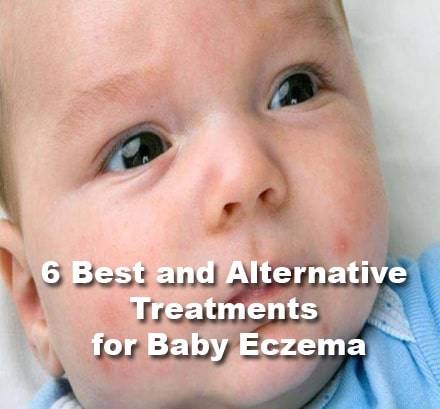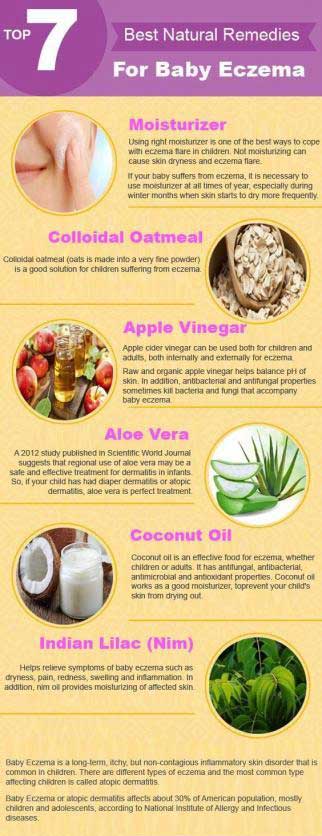Your child may be irritated by continuous itching and skin irritation due to baby eczema.
Baby Eczema is a long-term, itchy, but non-contagious inflammatory skin disorder that is common in children. There are different types of eczema and the most common type affecting children is called atopic dermatitis.

Baby Eczema or atopic dermatitis affects about 30% of American population, mostly children and adolescents, according to National Institute of Allergy and Infectious Diseases.
In children, this usually starts in the first 6 months or at any time during the first five years of child’s life. In some children, symptoms may persist after childhood and adolescence.
A 2010 study published in Journal of Investigative Dermatology revealed that 39% of Caucasian children developed eczema.
Interestingly, study found that growing children in dog-fed households are less likely to develop eczema at any age.
So far, experts have not identified exact cause of eczema in children. Some experts believe that this is caused by a lack of nutrition, while others believe that it may be caused primarily by an allergen or other irritating substance.
Some of common causes and factors leading to baby eczema are dry and sensitive skin cracking, poor immune system, environmental conditions, allergies and temperature changes to laundry detergents or other chemicals.
In addition, vitamin D deficiency during pregnancy can increase risk of developing eczema in a child before age of 1 year. The symptoms of eczema may be mild to severe in children and may vary in location.
Common symptoms include:
- Small and fluffy patches that collect water and form a shell.
- Cracking thick, dry and scaly skin.
- Hand, foot, ankle, wrist, neck, upper chest, eyelid, skin folds, and red or brown spots on face and scalp of infants.
- Sensitive skin with swollen and scratch-free skin.
- Intense itching. (often disrupts sleep patterns)
- Skin rashes.
- As there is no definitive cause of eczema, there is no defined treatment.
- However, there are some effective natural methods that can help prevent future exacerbations and alleviate discomfort of outbreak.
Moisturizer
Using right moisturizer is one of the best ways to cope with eczema flare in children. Not moisturizing can cause skin dryness and eczema flare.
If your baby suffers from eczema, it is necessary to use moisturizer at all times of year, especially during winter months when skin starts to dry more frequently.
Take a good moisturizer, use ointment rather than creams and apply it to your child’s skin to prevent it from drying.
Another natural option you can try is almond oil and keep your child’s skin moist for hours. It is best to apply moisturizers to wet skin after shower.

Colloidal Oatmeal
Colloidal oatmeal (oats is made into a very fine powder) is a good solution for children suffering from eczema.
It relaxes itchy skin and relieves leak. Contains antiiritan, anti-inflammatory and soothing properties that provide immediate relief. A 2012 study published in Clinical, Cosmetic and Research Dermatology revealed that colloidal oatmeal used in personal care products is a safe and effective agent.
In another study published in Dermatology Research and Practice Department in 2012, is recommended that softening agents such as colloidal oatmeal are used frequently and regularly to maintain skin barrier function in patients with mild atopic dermatitis even in absence of lesions.
- Pour 1 cup of colloidal oatmeal into a tub of warm water.
- Wash your child in this water for at least 15 to 20 minutes or sit in water.
- Use this method 1 or 2 times per day depending on severity of problem.
Alternatively:
- Add a little water to a few tablespoons of colloidal oatmeal and leave to a consistency.
- Apply this mixture to itchy skin, wrap with a cloth and leave for 30 minutes.
Use this method once a day.
Apple Vinegar
Apple cider vinegar can be used both for children and adults, both internally and externally for eczema.
Raw and organic apple vinegar helps balance pH of skin. In addition, antibacterial and antifungal properties sometimes kill bacteria and fungi that accompany baby eczema.
- Add 2 cups of apple vinegar to warm bath water.
- Let your child sit in this bath for 15 to 30 minutes.
- Then dry skin and apply a mild moisturizer.
- Do this daily.
- Warning: Babies under 1 are not supposed to have honey due to botulism risk.
Alternatively:
- Equal amount of water is diluted with raw, unfiltered apple vinegar.
- Apply to itchy area using a cotton ball.
- Leave for 30 minutes, then rinse with warm water.
Do this once or twice a day.
- Add 1 teaspoon of raw, unfiltered apple vinegar into a glass of warm water.
- Add 1 teaspoon raw honey.
Have your child drink twice a day.
Aloe Vera
A 2012 study published in Scientific World Journal suggests that regional use of aloe vera may be a safe and effective treatment for dermatitis in infants.
So, if your child has had diaper dermatitis or atopic dermatitis, aloe vera is perfect treatment.
Aloe vera has anti-inflammatory properties that help soothe itching and burning sensation. In addition, its antimicrobial properties help prevent skin infection and moisturize skin.
- Remove aloe vera leaf and remove gel. You can also add a few drops of vitamin E oil to aloe vera gel.
- Apply directly affected area to gel.
- Allow to dry spontaneously, then rinse with warm water.
- Try this simple method twice a day for several weeks.
Coconut Oil
Coconut oil is an effective food for eczema, whether children or adults. It has antifungal, antibacterial, antimicrobial and antioxidant properties. Coconut oil works as a good moisturizer, toprevent your child’s skin from drying out.
Lauric acid is also a healthy vitamin and nutrient, such as vitamin K and vitamin E, which helps with itching and helps soften skin.
For best results, use non-refined, cold-pressed coconut oil.
In a study published in evidence-based Complementary and Alternative Medicine reports, it is reported that pure coconut oil works as an excellent emollient and natural antibacterial agent in addition to showing anti-inflammatory activity.
- Apply coconut oil directly to affected skin several times a day to get rid of itching.
- Continue to use until symptoms disappear completely.
- Add 1 to 2 tablespoons of extra pure coconut oil to your child’s diet to help relieve symptoms of eczema and improve general immunity.
- You can add it to your child’s food or drinks.
Indian Lilac (Nim)
The Indian lilac also known as nim, is another wonderful method for children suffering from eczema. Antibacterial, analgesic, anti-inflammatory and antimicrobial properties;
Helps relieve symptoms of baby eczema such as dryness, pain, redness, swelling and inflammation. In addition, nim oil provides moisturizing of affected skin.
- Dilute 5 or 6 drops of nim oil with a carrier oil.
- Apply a ball of cotton or ear stick to affected area and leave for 20 minutes.
- Wash oil with warm water.
- Repeat once or twice a day until you get results you want.
Alternatively:
- You can add a few drops of NIM oil to warm bath water and sit your baby in water for at least 20 minutes.
- Gently dry your skin and then apply a mild moisturizer.
- Use this treatment once a day.
